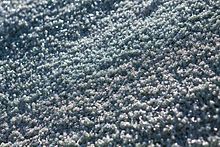Frit (material)
The term frit is an intermediate product in the manufacture of glass or ceramic melts . The glass frit, for example, is created by superficial melting of glass powder, whereby the glass grains bake together ( sintering ). Both the powder and the resulting material are referred to as frit. In some manufacturing processes, the resulting material is also quenched. The result is a porous material that is used as a filter in laboratory technology, for example . Finally, the quenched material can easily be ground into a powder, which is also called a frit.
Glass frit
The glass frit used to be manufactured in a separate frit furnace, quenched and stored in a frit chamber as a direct raw material for the glass melt. As an example, the production of forest glass :
The melt ran off in two steps. First, the raw materials (two parts by weight of ash, one part of quartz sand) were mixed by the smelter to form a mixture . Then the mixture was "cooked" in the frit oven at approx. 750 ° C for one day and one night to fry. The frit must be stirred as soon as it gets hot so that it doesn't melt and cake in the heat of the fire. This ash-sand mixture was melted into glass as a new batch in the melting furnace . Glass frits are u. a. used as filter material. There are different porosities, which are listed in the table below.
| ISO 4793 marking | ' Identification' | Nominal size of the pores | Area of application of the frit |
| P 500 | POR 00 / G 00 | 250 - 500 µm | Filtration of coarse precipitates, gas distribution in liquids with low gas pressure |
| P 250 | POR 0 / G 0 | 160-250 µm | Filtration of coarse precipitates, gas distribution in liquids with low gas pressure |
| P 160 | POR 1 / G 1 | 100-160 µm | Coarse filtration, gas distribution with higher pressure |
| P 100 | POR 2 / G 2 | 40-100 µm | Preparative fine filtration, preparative work with crystalline precipitates, diffusion of gases in liquids |
| P 40 | POR 3 / G 3 | 16 - 40 µm | Analytical filtration, analytical work with medium-fine precipitates, preparative work with fine precipitates, diffusion of gases in liquids |
| P 16 | POR 4 / G 4 | 10-16 µm | Analytical fine filtration, analytical and preparative work with very fine precipitates, very fine gas distribution in liquids by means of pressure, shut-off valves for mercury |
| P 1.6 | POR 5 / G 5 | 1 - 1.6 µm | Fine filtration, bacteriological filters, filtration of larger microorganisms, extremely fine gas distribution in liquids by means of high pressure |
Enamel frit
In the early ceramic production, the temperature required for tight firing (stoneware 1200 ° C, porcelain 1400 ° C) was not reached and a glaze had to be applied in order to use the product as a vessel. For that were broken with suspensions of the glaze ingredients in water (frit, powder, dissolved in water) poured, molded or daubs. The "low-burned" products have the disadvantage that toxic heavy metals are not completely glazed in the paint and can be dissolved out by liquids over the long term.
Today, enamel frit is used in the manufacture of enameled metals and other materials.
See also
- Frit porcelain
- Sintering - supplies porous metal components, which are sometimes also called frits
- Frit (filter)
- Glass crumbs
Web links
Individual evidence
- ^ Küster Thiel calculation tables for chemical analysis 102nd edition, de Gruyter, 1982. Page 256f.
